Alexandra Grablewski
Babies are naturally gassy, but you can take preventive measures to keep your little one comfortable. Find out how. @ Anita K. Henry
New parents are often surprised at the big noises that come out of a small baby. In fact, newborns can be quite the audible orchestra and gas is often part of the repertoire. It’s a natural and common occurrence in infants and although some babies seem to have no trouble passing gas, others can get a little stuck. Here’s how to spot a baby with gas and help her pass it.
What to Look For
Babies can’t simply tell us when they need to pass gas, so as with many things involving small children, discovering what’s bugging your baby is often a process of elimination. But before you blame the bubbles, it’s important to note a couple of things. Every baby is a gassy baby. “Babies eat around the clock,” says Ari Brown, M.D., an Austin-based pediatrician and the author of Baby 411. “So their bowels move around the clock, producing endless gas.” Frequency of gas is generally not a cause for concern, and a fussy baby might be perfectly normal, too. Unlike adults, babies pass gas with a little less decorum and a lot more enthusiasm. “She may seem uncomfortable or just downright fussy when she’s got some gas that needs to come out,” Dr. Brown says. “But it’s rare that a baby will actually have discomfort due to gas.” This spirited spectacle could just be your baby’s regular gas-passing antics.
But if you suspect that your extra fussy baby is genuinely uncomfortable, and she keeps squirming and pulling up her legs, she might very well have some gas that refuses to pass. The best way to confirm your suspicions is to try some gas-relieving techniques. “If your baby seems much better after passing gas, then that’s a telltale sign that the problem was gas,” says Jennifer Shu, M.D., an Atlanta-based pediatrician and coauthor of Food Fights: Winning The Nutritional Challenges of Parenthood Armed with Insight, Humor, and A Bottle of Ketchup.
Deal with the Problem
If you have a gassy baby on your hands, there are several things you can do to help coax the gas out. Start by placing your baby on a flat surface, belly down. Lifting her up slightly on her stomach, gently massage her belly. Or place her on her back and “try moving her legs and hips around as if she [were] riding a bike,” Dr. Brown says. Often these kinds of motions break up bubbles and give gas that little extra push it needs to work its way out. “You can also try a nice, warm bath to relieve the discomfort,” Dr. Brown adds.
If you’re still faced with an unhappy infant, you might want to consult with your pediatrician about trying some gas drops. “Some babies are said to respond well to over-the-counter anti-gas drops containing simethicone,” Dr. Shu says. Products with this ingredient include Gerber Gas Relief Drops, Mylicon, and Phazyme. Another option is to consider what might be causing the excess gas and see if you can reduce the bubble intake from the get-go.
Employ Preventive Measures
Bring on the Burps. Feeding time can come with a lot of crying, gulping, guzzling, and suckling — in other words, a lot of air, which eventually manifests itself in the form of a burp or gas. “And while relief from a burp might be more immediate, air that exits as gas has a longer journey through the intestinal tract first,” Dr. Shu says. Try being a little extra vigilant about burping your baby during and after a feeding to see if you can keep some of the gas at bay.
Settle Down. Bottle-fed babies can ingest a lot of bubbles. To combat this, tilt the bottle at an angle that fills the entire nipple with milk. “Otherwise your baby will suck in air,” Dr. Shu says. “More swallowed air means potentially more gas.” If you feed your baby a powdered formula, try to let the bottle settle first before giving it to your baby. There’s a whole lot of shaking going on and the bottle is often piled high with bubbles on top of the actual formula. Ready-made formula and specially vented bottles may also help reduce the amount of bubbles in the bottle.
Adjust the Angle. “When you’re feeding your baby, make sure her head is higher than her stomach,” Dr. Shu advises. You want to hold your baby in a position that allows the liquid to slowly sink to the bottom while the bubbles rise to the top. If you keep the bubbles closer to the surface, the natural — and easiest — means of exit is a burp. Bubbles that are trapped will likely pass in the form of gas.
Examine the Menu. Certain kinds of foods — those that are harder to digest — are known to cause excess gas, and the introduction of solid foods can be a definite game changer in the world of infant gas. So if you’re contending with a particularly fussy or constantly gassy baby, it might be worth taking a look at her diet — and yours. The gas-causing food you eat turns up in your breast milk, which might mean extra gas for your baby.

